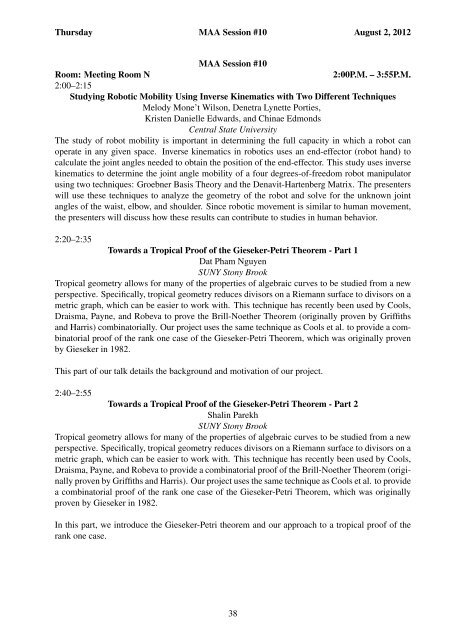Pi Mu Epsilon - Mathematical Association of America
Pi Mu Epsilon - Mathematical Association of America
Pi Mu Epsilon - Mathematical Association of America
Create successful ePaper yourself
Turn your PDF publications into a flip-book with our unique Google optimized e-Paper software.
Thursday MAA Session #10 August 2, 2012<br />
MAA Session #10<br />
Room: Meeting Room N<br />
2:00P.M. – 3:55P.M.<br />
2:00–2:15<br />
Studying Robotic Mobility Using Inverse Kinematics with Two Different Techniques<br />
Melody Mone’t Wilson, Denetra Lynette Porties,<br />
Kristen Danielle Edwards, and Chinae Edmonds<br />
Central State University<br />
The study <strong>of</strong> robot mobility is important in determining the full capacity in which a robot can<br />
operate in any given space. Inverse kinematics in robotics uses an end-effector (robot hand) to<br />
calculate the joint angles needed to obtain the position <strong>of</strong> the end-effector. This study uses inverse<br />
kinematics to determine the joint angle mobility <strong>of</strong> a four degrees-<strong>of</strong>-freedom robot manipulator<br />
using two techniques: Groebner Basis Theory and the Denavit-Hartenberg Matrix. The presenters<br />
will use these techniques to analyze the geometry <strong>of</strong> the robot and solve for the unknown joint<br />
angles <strong>of</strong> the waist, elbow, and shoulder. Since robotic movement is similar to human movement,<br />
the presenters will discuss how these results can contribute to studies in human behavior.<br />
2:20–2:35<br />
Towards a Tropical Pro<strong>of</strong> <strong>of</strong> the Gieseker-Petri Theorem - Part 1<br />
Dat Pham Nguyen<br />
SUNY Stony Brook<br />
Tropical geometry allows for many <strong>of</strong> the properties <strong>of</strong> algebraic curves to be studied from a new<br />
perspective. Specifically, tropical geometry reduces divisors on a Riemann surface to divisors on a<br />
metric graph, which can be easier to work with. This technique has recently been used by Cools,<br />
Draisma, Payne, and Robeva to prove the Brill-Noether Theorem (originally proven by Griffiths<br />
and Harris) combinatorially. Our project uses the same technique as Cools et al. to provide a combinatorial<br />
pro<strong>of</strong> <strong>of</strong> the rank one case <strong>of</strong> the Gieseker-Petri Theorem, which was originally proven<br />
by Gieseker in 1982.<br />
This part <strong>of</strong> our talk details the background and motivation <strong>of</strong> our project.<br />
2:40–2:55<br />
Towards a Tropical Pro<strong>of</strong> <strong>of</strong> the Gieseker-Petri Theorem - Part 2<br />
Shalin Parekh<br />
SUNY Stony Brook<br />
Tropical geometry allows for many <strong>of</strong> the properties <strong>of</strong> algebraic curves to be studied from a new<br />
perspective. Specifically, tropical geometry reduces divisors on a Riemann surface to divisors on a<br />
metric graph, which can be easier to work with. This technique has recently been used by Cools,<br />
Draisma, Payne, and Robeva to provide a combinatorial pro<strong>of</strong> <strong>of</strong> the Brill-Noether Theorem (originally<br />
proven by Griffiths and Harris). Our project uses the same technique as Cools et al. to provide<br />
a combinatorial pro<strong>of</strong> <strong>of</strong> the rank one case <strong>of</strong> the Gieseker-Petri Theorem, which was originally<br />
proven by Gieseker in 1982.<br />
In this part, we introduce the Gieseker-Petri theorem and our approach to a tropical pro<strong>of</strong> <strong>of</strong> the<br />
rank one case.<br />
38
















